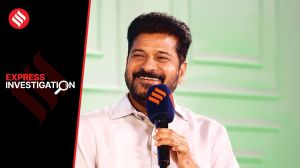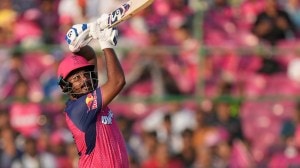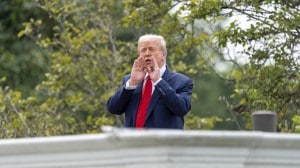Pune’s Deccan Gymkhana, where India defeated the Soviet Union to reach the 1974 Davis Cup final
A landmark sporting institution in the heart of Pune, the Deccan Gymkhana laid the foundation for a sporting culture in the city and gave rise to several international and national-level sportspersons.
 Along with western sports like cricket and tennis, the Deccan Gymkhana also made rules for indigenous games like Atya-Patya, Khokho and Hututu and printed them in a booklet in 1910. (Express photo)
Along with western sports like cricket and tennis, the Deccan Gymkhana also made rules for indigenous games like Atya-Patya, Khokho and Hututu and printed them in a booklet in 1910. (Express photo)On September 23, 1974, The New York Times published an article on one of the biggest moments in Indian sporting history from Poona. ‘India Ousts Soviet Union In Davis Cup’, the headline read, reporting how a team led by the Amritraj brothers advanced to the 1974 Davis Cup final by defeating the Soviet Union.
The matches were held at Deccan Gymkhana, a landmark sporting institution within the heart of Pune city. With world-class sports infrastructure and easy accessibility, the gymkhana laid the foundation for a sporting culture in the city and gave rise to several international and national-level sportspersons.
“The three-day matches that were held on the Deccan Gymkhana’s grass courts had attracted over 4,000 people from the city and we had brothers Anand and Vijay Amritraj, Ramanathan Krishnan as the non-playing captain and local boy Shashi Menon. It was the tie we won and it was huge as Soviet Union’s Alex Metreveli was the number one player for Russia and the runner-up in the 1973 Wimbledon,” said Nandan Bal, former Indian Davis Cup coach.
 India Team at the Davis Cup tie against Soviet Union, 1974
India Team at the Davis Cup tie against Soviet Union, 1974
A visionary and his dream
On October 5, 1906, Balakrishna Narayan Bhajekar, known as ‘Bandopant Bhajekar’, along with the help of the members of the Poona Young Men’s Cricket Club and the enthusiastic support of his cousin L R Bhajekar established a new sporting institution – the Deccan Gymkhana.
 Balakrishna Narayan Bhajekar ‘Bandopant Bhajekar’
Balakrishna Narayan Bhajekar ‘Bandopant Bhajekar’
“Describing his vision, Bandopant personally obtained donations for its creation from Maharaja Shahu of Kolhapur State, Sir Parshurambhau Saheb of Jamkhandi State, and Nanasaheb, Chief Administrator of Mudhol State, who became the first patrons of the Gymkhana. He also worked to get generous amounts from the Athalye and Sathaye Memorial Funds which helped to erect the gymnasium building,” writes Neelima Raddi, Bhajekar’s granddaughter in her book Legacy.
“It has to be appreciated that erstwhile Poona had just overcome the plague; there was friction in the political atmosphere as well. Poona was orthodox and conservative in many areas. Bhajekar’s vision to make Indians at par with English sportspersons was often met with resistance – from not using a leather ball to women not being allowed in sports. However, Bhajekar stayed firm to pave the way for his dream to become a reality,” said Shrirang Raddi, Bhajekar’s great-grandchild.
Since its inception, the Deccan Gymkhana had the support of Lokmanya Bal Gangadhar Tilak, a leader of the Indian independence movement, and got the patronage of Lord Harris, Lord George Lloyd, Maharaja of Kolhapur, Maharaja of Baroda, Raja of Jamkhandi, chief of Mudhol and other princely states. Politician and reformer Gopal Krishna Gokhale was the first president of Deccan Gymkhana. In 1918, Dorabji Tata became the president of the institution, where he supported the work of the Deccan Gymkhana to have India on the international map.
Giving rise to a sporting culture
“The first Indian Olympic trials for athletics were conducted on the grounds of the Deccan Gymkhana and seven athletes from the trials were part of the first Indian team to take part in the Antwerp Olympics in 1920,” said Jay Apte, a member of the governing body at Deccan Gymkhana.
Along with western sports like cricket and tennis, the Deccan Gymkhana also made rules for indigenous games like Atya-Patya, Khokho and Hututu and printed them in a booklet in 1910. In 1920, mainly through the efforts of S R Bhagwat, the general secretary of the Deccan Gymkhana, and at the instance of Bandopant Bhajekar, women’s sports tournaments were also held in Poona.
“In the same year, a special wrestling stadium, big enough to hold even 30,000 spectators, was constructed on our premises…provided ample accommodation for spectators at our Wrestling and Athletic Tournaments…Over 100 contests are held on the day, and thousands of villages around Poona attend them along with the people in the city…,” a statement by A R Sirdesai, general secretary of the Deccan Gymkhana, on the foundation day in 1928, reads.
The gymkhana’s objective in holding these contests was “to encourage village sports, and to further the physical development of the countryside”, the statement adds. “The big tournaments which kept many Gymkhana members at work at the Gymkhana day and night for days gave rise to the idea of founding a colony for Gymkhana workers on its premises. Accordingly, over 30 acres were taken on lease for 198 years in 1921, and after leaving about half of it for sports, the rest was laid out into a colony for Gymkhana members,” the statement further says.
A passion for tennis
Under the aegis of Dr G A Ranade, the Deccan Gymkhana hosted Davis Cup matches between India and Pakistan in 1963, against Germany in 1970 and against the Soviet Union in 1974.
“G.A Ranade was very passionate about the game and ensured that Deccan Gymkhana flourished as a tennis hub. In 1970, we had the India-Germany Davis Cup where we had Premjit Lall, Jaidip Mukerjea and Ramanathan Krishnan who were legends of their time. Unfortunately, Germany at that time was too strong and we lost to Wilhelm Bungert and Christian Kuhnke, who were among the top 20 tennis players at that time,” Bal recalled.
“Then we had the India vs Soviet Union tie where we won and I remember both ties vividly because it was the same time I started my tennis and we were all volunteering as ball boys. We could see the matches up close and at the time we used to get fantastic crowds who knew the sport. They had the etiquette of the sport, like when to clap and when not to. The foreign players appreciated this, that if they hit a good shot, it was bound to be applauded,” Bal said.
Bal added that the matches were played at grass courts where the Deccan Gymkhana cricket pitch currently exists. “The present cricket pitch at the Deccan Gymkhana was once eight grass tennis courts and all the major matches were held on the courts,” he said.
Apte said that the cricket pavilion, named after Bhajekar, is where the present Deccan Gymkhana police station stands.
From badminton to water sports
In 1921, additional land was taken on lease from the landlord Shirole Patil and the bungalow plot scheme was started for the members of Deccan Gymkhana. The Vanita Vishram department was also started exclusively for women. In 1956, to commemorate the Golden Jubilee of Deccan Gymkhana, a Suvarna Smruti Hall was built which had two badminton courts.
“Bandopant had often expressed regret that Pune, with two rivers flowing through it, still lacked proper swimming facilities for citizens. It was proposed that a swimming pool be created from the rocky banks of the river adjacent to the club area. That eventually developed into the popular Tilak Tank swimming pool we see today,” writes Neelima Raddi.
In 1921, water sports began at the Deccan Gymkhana at the Tilak Tank which gets all the water through the underground aquifers. “It was among the first pools in the city to facilitate the requirement for water sports and I met my sport of water polo in Deccan Gymkhana…The year 1992 was the golden year for Deccan Gymkhana in water polo as 13 players were selected for the national team,” said Sanjay Karandikar, bronze medallist at the Asian Games in 1982 in water polo.
“Bandopant’s principles would not allow him to neglect women’s physical health and fitness. In his opinion, it was vitally important that women actively benefit from sports and education. His unshakable conviction was that a nation’s future was only as strong as the physical and mental strength of its women,” writes Neelima Raddi.
The Deccan Gymkhana presently counts a great number of women as active sportsmen and members and started the ‘B.N Bhajekar Best Women Athlete Award’ this year to honour exceptional performance in sports among women.
Currently, the Deccan Gymkhana houses a cricket ground with a pavilion, 11 tennis courts (hard and clay), Olympic-standard 50 m and 25 m swimming pools, four basketball courts, three volleyball courts, billiards and snooker halls, table tennis, card game facilities and a well-equipped gymnasium. “Many members of the Bhajekar family were in sports to some capacity. I too played basketball in the Gymkhana’s premises as a child…but if you ask me, it was only my grand-uncle Ram Bhajekar who took sports professionally and went on to be part of the Ranji team for Maharashtra,” said Shrirang Raddi.
Bal said that while the club, which is over a century old, has grown and has modernised, it still holds on to remnants of a local, down-to-earth atmosphere. “It is still one of the few clubs which has maintained that sports are the most important thing. If one wants to find a good sporting environment with a good ambience to play and participate in sports, I will always think of Deccan Gymkhana,” he said.












